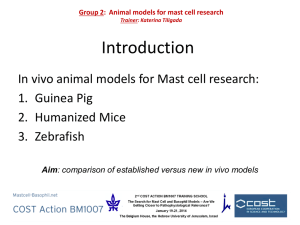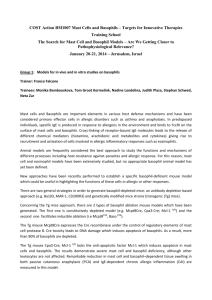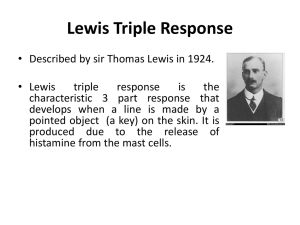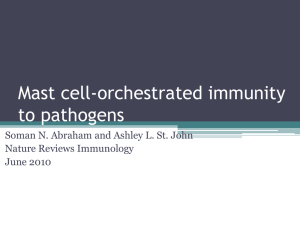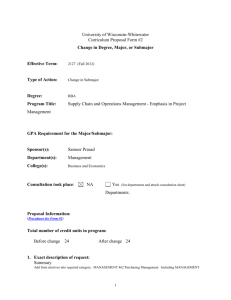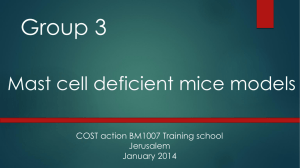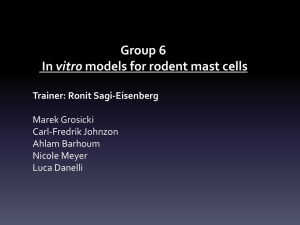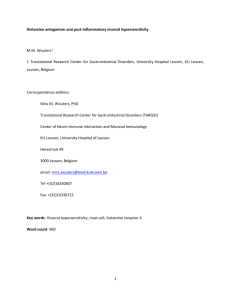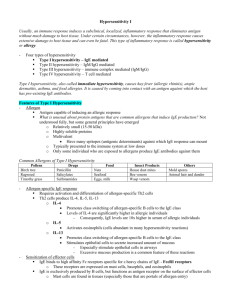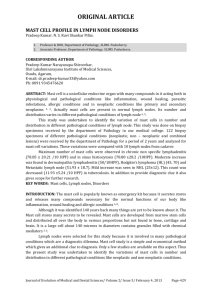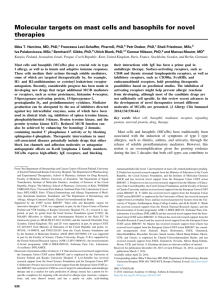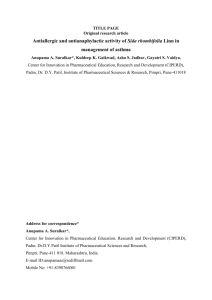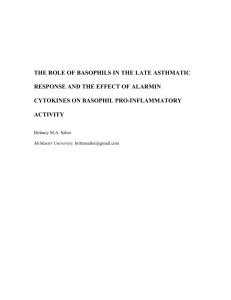Group_2_Abstract - Mast Cell
advertisement
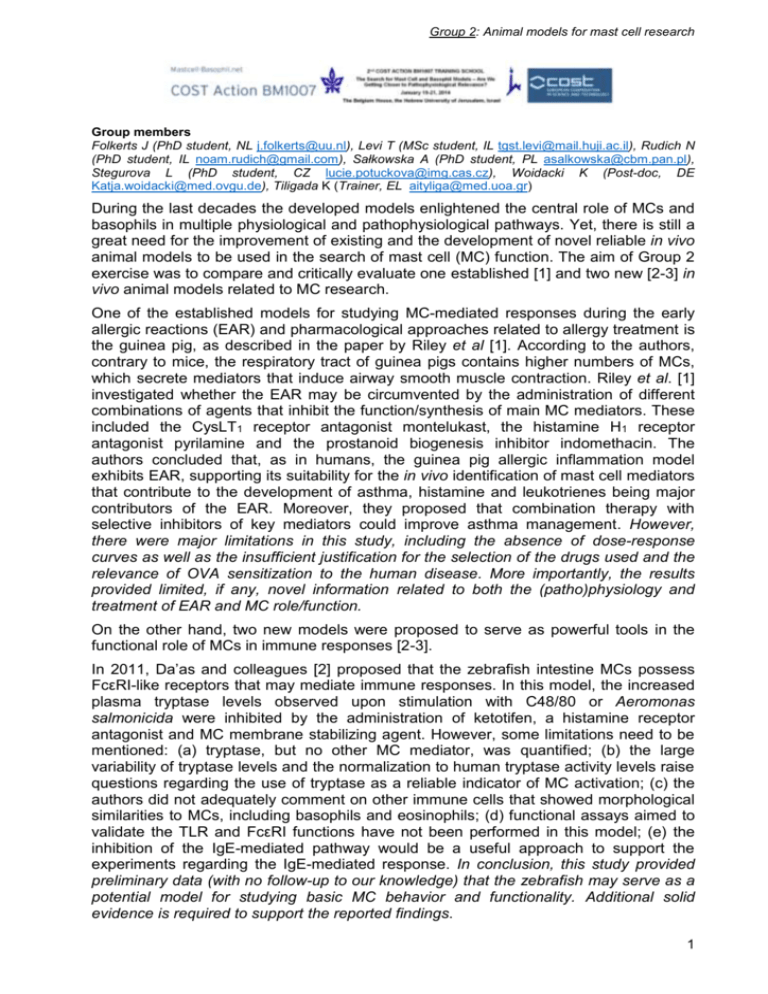
Group 2: Animal models for mast cell research Group members Folkerts J (PhD student, NL j.folkerts@uu.nl), Levi T (MSc student, IL tgst.levi@mail.huji.ac.il), Rudich N (PhD student, IL noam.rudich@gmail.com), Sałkowska A (PhD student, PL asalkowska@cbm.pan.pl), Stegurova L (PhD student, CZ lucie.potuckova@img.cas.cz), Woidacki K (Post-doc, DE Katja.woidacki@med.ovgu.de), Tiligada K (Trainer, EL aityliga@med.uoa.gr) During the last decades the developed models enlightened the central role of MCs and basophils in multiple physiological and pathophysiological pathways. Yet, there is still a great need for the improvement of existing and the development of novel reliable in vivo animal models to be used in the search of mast cell (MC) function. The aim of Group 2 exercise was to compare and critically evaluate one established [1] and two new [2-3] in vivo animal models related to MC research. One of the established models for studying MC-mediated responses during the early allergic reactions (EAR) and pharmacological approaches related to allergy treatment is the guinea pig, as described in the paper by Riley et al [1]. According to the authors, contrary to mice, the respiratory tract of guinea pigs contains higher numbers of MCs, which secrete mediators that induce airway smooth muscle contraction. Riley et al. [1] investigated whether the EAR may be circumvented by the administration of different combinations of agents that inhibit the function/synthesis of main MC mediators. These included the CysLT1 receptor antagonist montelukast, the histamine H1 receptor antagonist pyrilamine and the prostanoid biogenesis inhibitor indomethacin. The authors concluded that, as in humans, the guinea pig allergic inflammation model exhibits EAR, supporting its suitability for the in vivo identification of mast cell mediators that contribute to the development of asthma, histamine and leukotrienes being major contributors of the EAR. Moreover, they proposed that combination therapy with selective inhibitors of key mediators could improve asthma management. However, there were major limitations in this study, including the absence of dose-response curves as well as the insufficient justification for the selection of the drugs used and the relevance of OVA sensitization to the human disease. More importantly, the results provided limited, if any, novel information related to both the (patho)physiology and treatment of EAR and MC role/function. On the other hand, two new models were proposed to serve as powerful tools in the functional role of MCs in immune responses [2-3]. In 2011, Da’as and colleagues [2] proposed that the zebrafish intestine MCs possess FcεRI-like receptors that may mediate immune responses. In this model, the increased plasma tryptase levels observed upon stimulation with C48/80 or Aeromonas salmonicida were inhibited by the administration of ketotifen, a histamine receptor antagonist and MC membrane stabilizing agent. However, some limitations need to be mentioned: (a) tryptase, but no other MC mediator, was quantified; (b) the large variability of tryptase levels and the normalization to human tryptase activity levels raise questions regarding the use of tryptase as a reliable indicator of MC activation; (c) the authors did not adequately comment on other immune cells that showed morphological similarities to MCs, including basophils and eosinophils; (d) functional assays aimed to validate the TLR and FcεRI functions have not been performed in this model; (e) the inhibition of the IgE-mediated pathway would be a useful approach to support the experiments regarding the IgE-mediated response. In conclusion, this study provided preliminary data (with no follow-up to our knowledge) that the zebrafish may serve as a potential model for studying basic MC behavior and functionality. Additional solid evidence is required to support the reported findings. 1 Group 2: Animal models for mast cell research The translation of findings from animal models to human (patho)physiology remains an obstacle in biomedical research. Physiological readouts of allergic responses can greatly differ between mouse and man, thereby reducing the potential for generating new therapeutic approaches. Recently, Ito et al [3] established a human allergy model by using the human IL-3/GM-CSF-transgenic NOG mice. In contrast to other humanized mouse models, the transplantation of hematopoietic human CD34+ cells was associated with the development of FcεR-expressing mature MCs and basophils based on bearing human IL-3 and GM-CSF genes. These mice where capable of developing passive cutaneous anaphylaxis induced either by nitrophenylacetyl (NP) or serum from cedar pollinosis patients. However, although successful allergic reactions, including histamine release, were confirmed in the passive cutaneous anaphylaxis model, in most humans, active sensitization occurs. Moreover, there is a need for comparison studies to address any differences between allergic responses induced in classical mouse strains and transplanted humanized mice. In conclusion, the humanized mouse models may be a useful tool for developing anti-allergic drugs in the future and the findings are a significant step forward in translational medicine. Yet, this model needs to be validated in additional allergic settings, such as asthma, atopic dermatitis and food allergy. In summary, we would like to emphasize that the reliability of in vivo animal models presents some limitations yet to be resolved in order to reach beneficial end-points. These include the need for the standardization of validation protocols as well as the harmonization of the suitability of a number of mediators and surface components that are used as markers in MC-related responses, the appropriateness of sensitization triggers/protocols, the properties of pharmacologically active agents, including the recently described ligand-directed signaling, etc. In addition, research using experimental animals needs to take into consideration animal strain and gender differences, besides age and diurnal variations, the threshold and baseline responses as well as the importance of considering inter- and intra-species variations related to immune cell-cell interaction, particularly in the case of Tg and humanized mouse models. Finally, as experimental animals differ from humans in various aspects, including MC/basophil phenotypes and behavior, we would like to propose the ‘visibility’ of negative results and the establishment of a comparative definition of MCs and basophils, consisting of a list of the minimal anatomical and functional (physiological, biochemical, genetic) characteristics of these cells in humans and in various experimental animal species. Acknowledgements We would like to thank the organizers for the warm hospitality and for providing this excellent opportunity to study mast cells and basophils during this very productive training school in the Holy Land. Training Material [1] Riley JP, Fuchs B, Sjöberg L, Nilsson GP, Karlsson L, Dahlén SE, Rao NL, Adner M (2013). Mast cell mediators cause early allergic bronchoconstriction in guinea-pigs in vivo: a model of relevance to asthma. Clin Sci (Lond) 125:533-42. doi: 10.1042/CS20130092. PubMed PMID: 23799245 [2] Da'as S, Teh EM, Dobson JT, Nasrallah GK, McBride ER, Wang H, Neuberg DS, Marshall JS, Lin TJ, Berman JN (2011) Zebrafish mast cells possess an FcɛRI-like receptor and participate in innate and adaptive immune responses. Dev Comp Immunol 35:125-34. doi: 10.1016/j.dci.2010.09.001. PubMed PMID: 20849876 [3] Ito R, Takahashi T, Katano I, Kawai K, Kamisako T, Ogura T, Ida-Tanaka M, Suemizu H, Nunomura S, Ra C, Mori A, Aiso S, Ito M (2013) Establishment of a human allergy model using human IL3/GM-CSF-transgenic NOG mice. J Immunol 191:2890-9. doi: 10.4049/jimmunol.1203543. PubMed PMID: 23956433 2

